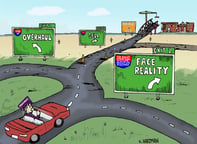Published on
Degrees in Jeopardy: Higher Ed’s AI Challenge to Curb Underemployment

With the rise of AI threatening positions for postsecondary learners and recent grads, higher ed must make sure to provide curricula that emphasize human skills, incorporates AI use and delivers the skills workers need to navigate the fast-changing working world.
Universities and colleges celebrate graduation day as a new class reaches a significant milestone, yet, these eager college graduates are entering a world vastly different from that of their predecessors. The traditional challenges of entering the workforce—gaining experience, networking and securing that crucial first job—are now confronted with an additional, revolutionary force: artificial intelligence (AI).
AI has fundamentally reshaped the landscape of entry-level positions. For instance, prestigious financial firms, which once eagerly hired young analysts in large numbers, are now contemplating reducing their intake by up to two-thirds as they replace these roles with AI systems. Similarly, data entry, once a common stepping-stone position, is increasingly being automated by algorithms. Research positions traditionally assigned to bright-eyed interns and entry-level employees are also being tackled by AI with startling efficiency. Even the realm of customer service, which has long been considered secure because of human interaction, is being encroached by AI chatbots and automated systems.
Perhaps most alarmingly, the very concept of internships is under threat. Internships represent crucial experiences that bridge the gap between academia and industry. With a significant majority of hiring managers believing that AI can perform intern-level work, the opportunities for students to gain real-world experience are shrinking just when they’re needed most. This threat also places more pressure on universities and colleges that require internships as part of their graduation requirements. With a shrinking pool of available internships, how can these institutions effectively support students in gaining the necessary experience to graduate successfully? This question becomes paramount in addressing AI’s role in shaping future internship opportunities.
In addition, the rise of AI threatens to exacerbate the problem of underemployment. Underemployment, where graduates work in jobs that don’t require their level of education or skills, has become a persistent problem affecting more than half of college graduates in their first year after leaving school. Even more troubling, this issue often persists long after graduation, with nearly half of graduates still underemployed a decade into their careers. AI adds to the underemployment issue by forcing college graduates to compete in an ever-shrinking pool of positions that truly utilize their skills and education. This reality could lead to a first-job trap, where graduates who start in positions below their skill level struggle to break out of the cycle of underemployment.
The financial implications of this trend are significant. While underemployed graduates still earn more than those with only a high school diploma, the wage gap between them and their peers in college-level jobs is substantial. This disparity can have long-lasting effects on career trajectories and lifetime earnings, potentially undermining the perceived value of a college education.
However, the impact of underemployment is not uniform across all graduates. Those from STEM fields, particularly in areas like computer science and engineering, tend to fare better with lower rates of underemployment. In contrast, liberal arts programs, in particular, face a moment of reckoning. Graduates from liberal arts programs face higher risks of underemployment unless swift and decisive action is taken. This stark disparity is not just a fleeting concern but a potential catalyst for a seismic shift in the liberal arts, where students must apply their creative thinking toward AI applications, ethics, privacy and bias. As a result, the liberal arts must reimagine their value propositions.
To combat this growing challenge, universities must address underemployment in the AI era through a collaborative effort among higher education institutions, policymakers and industry leaders. Universities must advocate for policies that support job creation in emerging fields and promote ethical AI implementation that complements rather than replaces human workers. They need to foster stronger ties with industry partners, not just for internship opportunities but to gain real-time insights into evolving hard and soft skill requirements. Career services departments must also be empowered to provide more targeted guidance that helps students navigate a job market filled with AI-augmented industries.
Moreover, sharing disaggregated data transparency will be critical. Universities should provide clear, data-driven information about postgraduation outcomes, including underemployment rates, to prospective and current students. This data can help students make more informed decisions about their educational and career paths, which may steer them toward fields with better employment prospects.
This transformative period will be especially challenging for status-quo universities and colleges. These institutions will struggle with creating a clear path from the graduation stage to full employment in an AI-driven world. Their status quo culture can exacerbate the challenges of aligning graduate outcomes with evolving employment needs.
As we stand at the dawn of this AI revolution, the challenge for higher education is clear: equip students, not just with knowledge but with the adaptability and skills to navigate a rapidly changing job market. It will require a delicate balance of embracing AI literacy while cultivating the irreplaceable human skills that will remain in demand. Universities must lead this charge, transforming not just what they teach but how they prepare students for a world where AI is an omnipresent colleague. By rising to this challenge, universities can ensure their graduates don’t just find jobs but become the innovators and leaders who shape the AI-integrated world of tomorrow, thereby mitigating the risks of underemployment.



